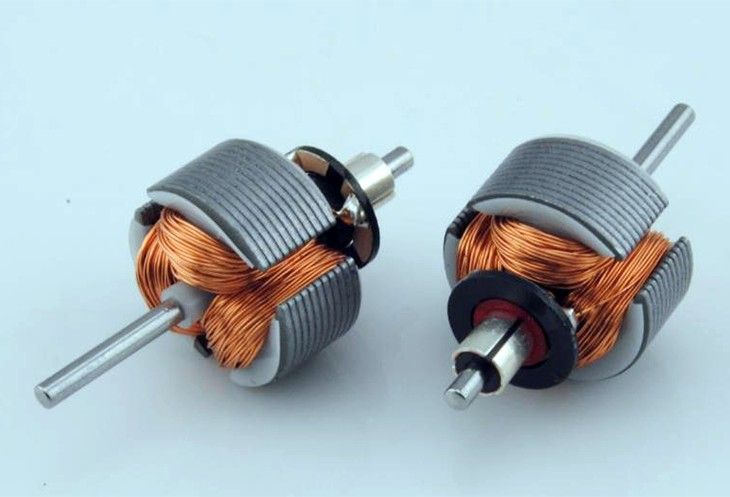Qalabka korantada ee badbaadada leh ee la xoojiyay, sida matoorada aan qarxin, Transformers, fiilooyinka korantada, iyo ballasts loogu talagalay nalalka dhaadheer, qayb ka mid ah dabaylaha gudaha. Shuruudaha dabaylahan, farsamo ahaan iyo koronto ahaanba, way ka sarreeyaan kuwa dabaylaha caadiga ah.

Guud ahaan, siliga dahaaran ee loo isticmaalo dabaylaha gariiradahan waa in ay labanlaab noqdaan, iyo dhexroorkii lagu qiimeeyay isku-darka ah waa inaysan ka yarayn 0.25mm.
Wixii siligga soo saarka loo isticmaalo ee loo adeegsaday dabaysha, Waxaa lagu talinayaa in la isticmaalo GB / T6109.2-2008 “Polyester wuxuu ka soo baxay wareega silig ee naxaas ah, Fasalka 155,” GB/T 6109.5-2008 “Polyester-imide-ka soo baxa wareega wareega naxaasta, Fasalka 180,” GB/T 6109.6-2008 “Polymimide-ka ayaa soo if baxay wareega silig, Fasalka 220,” ama GB / T6109.20-2008 “Polyamide-imide polyester ama polyester-imide-imide-ka oo soo if baxay silig copper, Fasalka 220.”
Intaa waxaa dheer, Darajo 1 soo kiciyey silig copper oo wareegsan sida lagu qeexay heerarkan waa la isticmaali karaa, haddii ay dhaafto tijaabooyinka la xiriira ee lagu qeexay heerarka.
Ka dib dabaysha, Wakiil ku habboon oo ku habboon waa in loo istcimaalaa si kor loogu qaado guryaha dahaarka ee dabaylaha.
Habka loo yaqaan 'Hawshu' waa inuu raacaa habka loo cayimay soo-saaraha, adoo adeegsanaya farsamooyinka sida qulqulka, khiyaameeya, ama cadaadiska cadaadiska cadaadiska (Vpa) Si loo buuxiyo nusqaamaha u dhexeeya fiilooyinka fiilooyinka oo hubiso adhesion xoog leh. Haddii wakiilka wakiilka ka kooban yahay solvents, Xaraashka iyo qalajinta waa in la sameeyaa laba jeer si loo oggolaado dareeraha xalka ah.
Guud ahaan, Qaababka sida lagu buufiyo ama dahaarka loogu talagalay khasabka dabaysha waxaa loo arkaa inay aan lagu aamini karin Qalabka korontada ee aan qarxin. Fursad ku filan waa in lagu siiyaa tan ku saabsan waxqabadka injineerinka.
Waxaa intaa dheer, Xaraashka korantada sare, Xaraashka hawaduhu waa in lagu daaweeyaa rinjiga anti-corona si looga hortago khataro dheeraad ah oo ay sababaan crona-ka.
Aaladda korantada ee amniga badbaadada, Haddii Motors, Xirmooyinka Electromagnetic, ama xirmooyinka qalabka kale ee qalabka, Waa in guud ahaan lagu qalabeeyaa heerkulka Aaladaha Ilaalinta si looga hortago in ka badnaan heerkulka xad-dhaafka ah ee qalliinka caadiga ah ama xaalado aan caadi ahayn la aqoonsan yahay.
Haddii dabayluhu ka badneyn heerkulka xadka ee hoos yimaada xad-dhaafka joogtada ah (sida qufulka gawaarida gawaarida), ama haddii dabayl aan lagu qasbin culeys xad dhaaf ah (Sida balastar loogu talagalay laambada iftiinka), markaa uma baahna aaladda ilaalinta heerkulka.
Markii qalabka korantada ee amniga lagu xoojiyey ay ku qalabaysan yihiin aaladaha ilaalinta heerkulka, Kuwaani waxaa lagu rakibi karaa gudaha ama dibedda. Aan laga walwalayn, Qalabka Ilaalinta waa inuu lahaado ku habboon nooca qarxinta waana in lagu qiimeeyaa iyadoo lala kaashanayo qalabka la ilaaliyo.
 Qaraxa Shenhai-Caddaynta
Qaraxa Shenhai-Caddaynta
